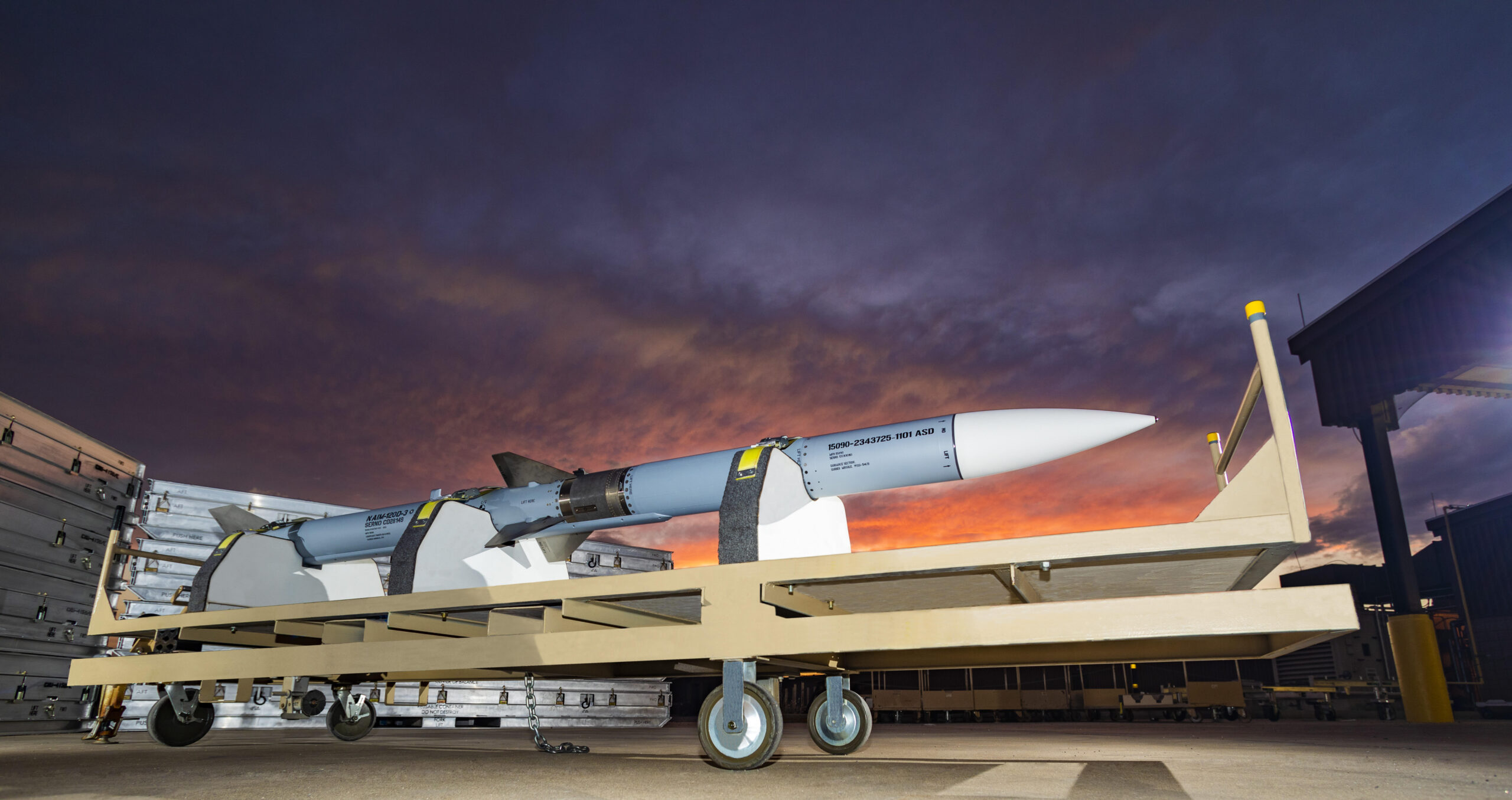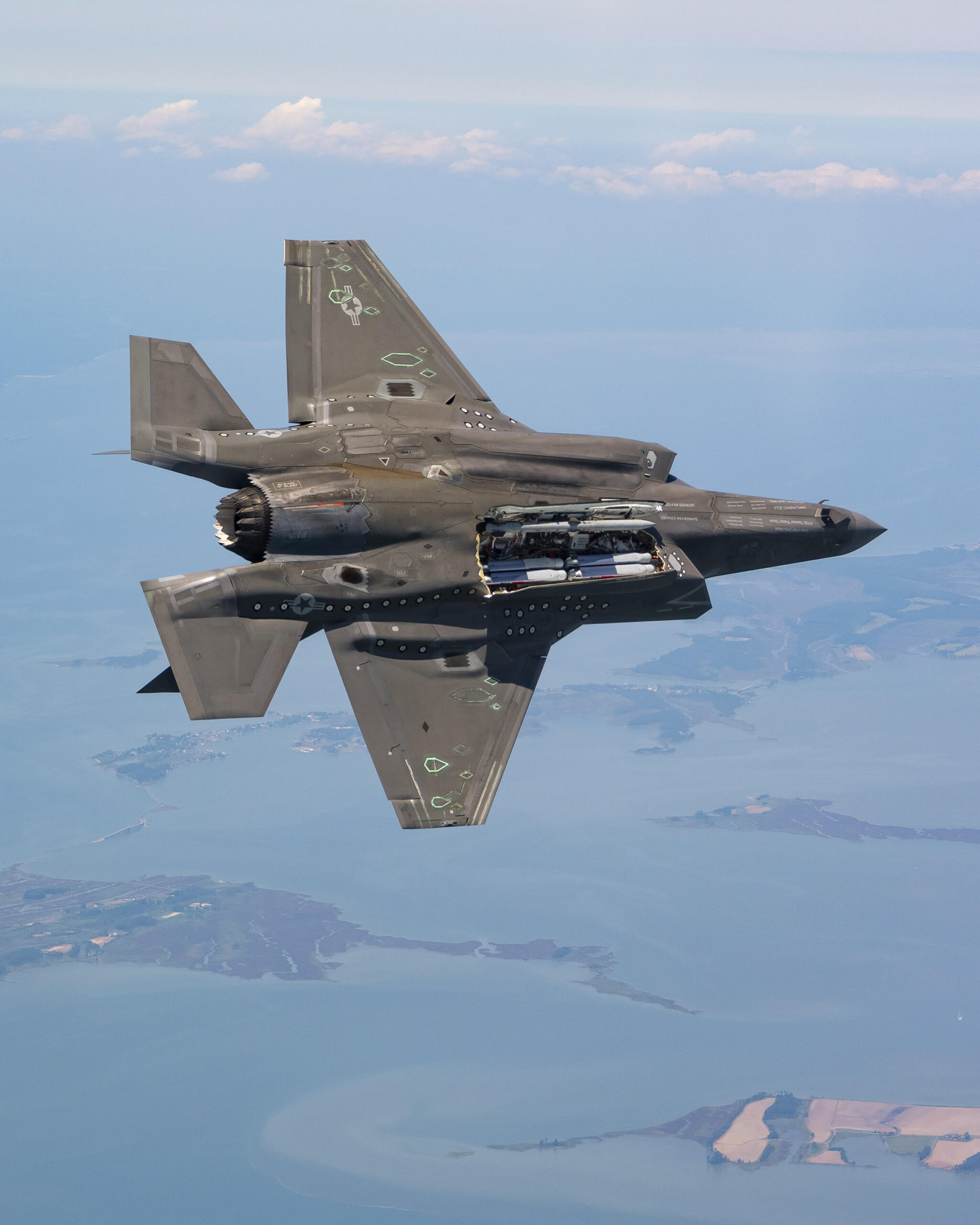
The new AMRAAM F3R, an AIM-120D3 missile, is the result of a hardware form, fit, function refresh and software upgrade.
In this Q&A with Steve Milano, director of Air to Surface Effects Requirements and Capability at Raytheon Missiles & Defense, we discuss: why air power doesn’t necessarily mean sustained air dominance, especially against near peers; the status of the upgraded AMRAAM F3R air-to-air missile; and the latest news on integrating the StormBreaker Smart Weapon on F-35s for the DoD and international customers.
Breaking Defense: What does “air power” mean in today’s threat environment (and in the upcoming National Defense Strategy) in terms of air-to-air and air-to-surface missiles? What does it mean to “control the nature of air dominance” in general?

Steve Milano, Director of Air to Surface Effects Requirements and Capability at Raytheon Missiles & Defense.
Milano: Air power means projecting capability into a complex threat environment. It’s the same terminology that we’ve used consistently, but what does that mean in the current context of the conflict we’re seeing in Ukraine and the pressures we’re seeing with China?
There are two different thrusts. The first is identifying how we will be contested across the electromagnetic spectrum to understand the command and control aspects of air dominance. The second half of that is how we operate from an air-to-air and air-to-surface capability within that contested environment to maintain air dominance.
Then there is the recent idea of sustained control or sustained air dominance versus temporary air-corridor control — the latter being introduced in the PACOM AOR specifically looking at area-denial attributes of China and how we want to operate in that airspace.
Many times it’s not about completely controlling the airspace. It’s about being able to create temporary pockets of dominance so that we can achieve mission sets. While I was thinking about the nature of air dominance, something that the Defense Science Board wrote rang true for me. That was whether air supremacy or dominance is realistic for the Air Force if we cannot be present in A2/AD battlespace at any time. That’s a key piece — at any time, day or night.
Furthermore, threat decoys and GPS-denial tactics that require US aircraft to use onboard sensors force those aircraft to highlight themselves. What that does is drive capability into the weapons so that they have the capability to be standoff and use passive or non-passive identification mechanisms on the platform in order to engage threats in an air-to-air or air-to-surface capability.
One of the most significant implications of threat asymmetries is that the US is going to need to establish a commitment for decades to come to build capability that sustains the appropriate capacity and readiness level to maintain air dominance in the face of shifting priorities.
That’s when I look to weapons and programs like AMRAAM that continue to be a staple in the evolving nature of air supremacy. It doesn’t necessarily require a vast, new exploration of capability. It’s an iterative process that evolves with the threat requirements to continuously meet the need at the speed of relevancy.
Rounding that out, air-to-surface effects are required to engage any capability aimed at limiting the projection of sustained air power. Advanced effects like the StormBreaker Smart Weapon and the Joint Strike Missile enable denied and contested environments to be opened up to achieve that mission.
Both of those weapons are designed for internal carriage on the F-35 and are capable of defeating an array of surface targets. That’s important because you maintain the stealthy attributes of the F-35 and are able to get to those targets, which goes back to my point about sustained control versus temporary air-dominance corridors.
Ultimately, air power is having the ability to achieve mission objectives in spite of the threat environment, and that requires robust air-to-air and air-to-surface capabilities like AMRAAM, StormBreaker, and the Joint Strike Missile.
Breaking Defense: The USAF successfully conducted the first AMRAAM F3R, an AIM-120D3 missile, live-fire test against a target. The test used production missile hardware developed under the AMRAAM Form, Fit, Function Refresh program and the SIP-3F software improvement program. Working together on the upgraded AMRAAM, how do those two programs help control the nature of air dominance?
Milano: You’re right, they’re complementary. Going back to the origin of the F3R program, it started off as an obsolescence redesign for 15 circuit cards in the forward stack, along with replacing the GPS/IMU. As we went through that process, we realized that modern technology has enabled us to open up the aperture and obtain advanced capabilities within the same outer mold line of the weapon, which is important when you’re trying to keep costs down on any program.
It enabled us to see that there was an easy pathway to realize exceptional capability within that existing platform. That is the F3R program, and when you bring F3R and the SIP 3 software together that’s when you’re delivering the capability of the D3 missile. The software portion of the D3 program that was introduced last year takes advantage of the increased processing power, the additional battery life, and the throughput that was enabled by the rejuvenation of those circuit cards. It’s taking advantage of the hardware and exploring the edges of that capability from both a software and hardware perspective.

Raytheon is working to integrate the network-enabled capability of StormBreaker with the Royal Norwegian Air Force. Shown is the internal carriage of StormBreaker on a USAF F-35.
Breaking Defense: Describe how the F3R program used model-based systems engineering initiatives and other digital technologies to upgrade multiple circuit cards and hardware into the guidance section of the missile and to re-host legacy software in the AIM-120D3 and AIM-120C8 AMRAAMs.
Milano: Through the use of model-based systems and engineering on the D3 program, we actually modeled the chip sets and the firmware that go into those 15 cards. As we moved from the proof of design to the proof of manufacturing aspects of those chips, digital fault tree analysis allowed us to understand where we were going to run into challenges so we could design for producibility, sustainability, and resiliency before we ever actually tested it in the weapon.
One of the unique challenges that any existing program of record runs into when they start to integrate some of these digital tool sets is the transition from development to actual production.
AMRAAM is taking on some of those digital production attributes in how we integrate the design space into the build-out of these circuit cards. A lot of that has come to fruition, but there’s also some natural friction and learning that’s going to go on between the digital development world and the physical cutting of hardware and integration of that into the production line. That’s learning we’re sharing with the Air Force, and it’s informing how they develop requirements in the future, as well.
Breaking Defense: Let’s move on to the StormBreaker glide bomb. What’s the latest news and upcoming developments with this program, especially as the program extends to F-35 partner nations like Norway.
Milano: As we increase capacity through our factory and domestic procurement hits its annual levels, we’re starting to see more of the international partners come online as they receive their F-35s. They want the complementary capability that StormBreaker provides.
The government of Norway confirmed its intention to procure the StormBreaker Smart Weapon from the Air Force, and so we’ve started our preparations to integrate the network-enabled capability of StormBreaker with the Royal Norwegian Air Force.
Additionally, the U.S. Department of State notified Congress of Germany’s intent to procure an initial quantity of 350 StormBreaker Smart Weapons to outfit their F-35s. This is the tip of the iceberg for the European demand as they start to receive F-35s and begin to sign Letters of Request for weapons packages associated with those F-35s. We’ll begin to see initial quantities being requested because it’s a capability that’s essentially a baseline for what you’re trying to accomplish when you procure that platform.
Switching over to the platform side, the F-35B STOVL is the program under test right now with operational testing and live-fire drops continuing. The software across the A, B, and C variants are all identical when it comes to the use and employment of StormBreaker, and so there’ll be a translation of that operational test profile that’s happening on the F-35B over to the other platforms, as well.
On the F-18E/F Super Hornet, we’ve completed all the required initial operational testing for the US Navy and look forward to supporting deployment.
Breaking Defense: Discuss AMRAAM and StormBreaker as critical components in the security of NATO countries.
Milano: As additional NATO nations select F-35, the packages associated with the platform vary based on the mission and commitment to the alliance. Creating sectors of air dominance and maintaining air power require the ability to engage advanced air-to-air threats, and when necessary, destroy surface targets that impede that capability. AMRAAM, StormBreaker, and the Joint Strike Missile continue to be the complement for the F-35 that the NATO partners have requested to achieve these goals.
The commonality and inventory capacity for these weapons systems continue to be an enabler for the successful deterrent and engagement throughout NATO. That’s why our focus has been on aligning with the US government’s intention to expand the F-35 program across NATO partners and provide a baseline weapons capability that includes the air-to-air capability of AMRAAM and the air-to-ground capability of both the Joint Strike Missile and StormBreaker as the baseline for every F-35 so that there is a commonality of capability across all of the partners.
Breaking Defense: Final thoughts?
Milano: The US Air Force has put out their operational imperatives of what’s important for today’s fight and for the immediate future. As we look across the programs that we have and the requirements that are being issued, it’s important to understand that there’s a balance between iterating existing capability and achieving truly revolutionary capability delivered within the construct because you go to the fight with the capacity and the capability that you can deliver today.
The takeaway is that the AMRAAM F3R program, StormBreaker, the integration of the Joint Strike Missile, and deliveries of those weapons are capabilities available today. They answer the requirements to defeat advanced and complex threats in the current and future environment.























